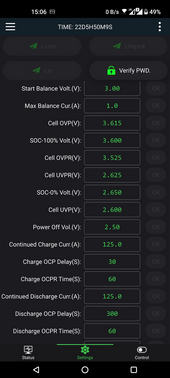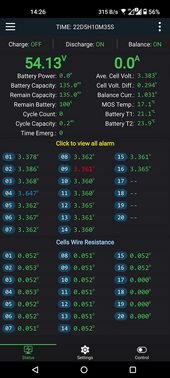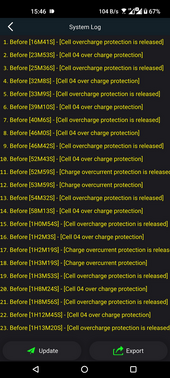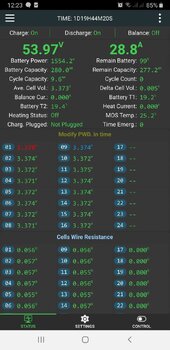brainwashed
New Member
I'm using an MPP Solar 6048MT with a DIY 48V 125Ah battery. The battery is fitted with a 150A JK-BMS. My goal is to use the sun whenever possible, charge the battery if some extra remains, use the battery until a safe low voltage then switch to grid. In the winter months it will most likely be on the low level. A 5% reserve is good for those rare outages. So let's say discharge until 30% if everything is fine, switch to grid, switch to battery until 25% if the grid power is out. No idea how to map voltages to percentage for LFP, I'm just going with conservative numbers.
Inverter:
- battery type: user
- cut-off voltage: 42
- bulk 56.4V
- float 54.4V
- battery equalization off
- back to grid voltage 44
- back to discharge voltage 48
BMS:
- start balance 3V
- cell OVP 3
- SOC 100% 3.5V
- cell OVPR 3.55V
- cell UVPR 2.65V
- SOC 0% 2.65V
- cell UVP 2.6V
- power-off 2.5V
- charge OTP 70C
- charge OTPR 60C
- discharge OTP 70
- discharge OTPR 60
- charge UTP 2C
- charge UTPR 5C
Discharge current is set to 125A, charge current to 50A but will be raised later. My maximum load will be around 5kW.
I have noticed that the inverter shows a very high battery state: 81% for 50.3V while the BMS shows 12-13% for the same value. I also had to calibrate the total BMS voltage as it was under-reporting by 0.4V. I have not done any voltage calibration for cells, can do it if needed.
Inverter:
- battery type: user
- cut-off voltage: 42
- bulk 56.4V
- float 54.4V
- battery equalization off
- back to grid voltage 44
- back to discharge voltage 48
BMS:
- start balance 3V
- cell OVP 3
- SOC 100% 3.5V
- cell OVPR 3.55V
- cell UVPR 2.65V
- SOC 0% 2.65V
- cell UVP 2.6V
- power-off 2.5V
- charge OTP 70C
- charge OTPR 60C
- discharge OTP 70
- discharge OTPR 60
- charge UTP 2C
- charge UTPR 5C
Discharge current is set to 125A, charge current to 50A but will be raised later. My maximum load will be around 5kW.
I have noticed that the inverter shows a very high battery state: 81% for 50.3V while the BMS shows 12-13% for the same value. I also had to calibrate the total BMS voltage as it was under-reporting by 0.4V. I have not done any voltage calibration for cells, can do it if needed.






